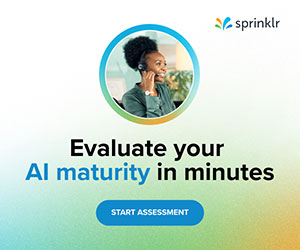Speech analytics is starting to enter the mainstream. But like most new technologies there have been some teething pains along the way.
In this article Martin Hill-Wilson looks at what has been holding back speech analytics and where it is likely to be moving in the future.
Before I start I must tell you that I’m a ‘sunny side up’, long-term fan of analytics. Anything that helps improve customer service gets a tick in my book.
Right now I’m watching text analytics go through a phase of teething pains as it powers the first generation of listening platforms. This is analytics for the social media generation. Just like the first primitive versions of speech analytics, it’s used to spot key words and phrases about organisations.
I must admit, though, I’m more interested in speech analytics. I find there is more interesting stuff going on because its feature set and operational methodology have already been refined by the first generation of early adopters. As a result, it’s sitting at the edge of a much broader uptake. And crucially, business benefits are more widely circulated and appreciated for their transformative commercial impact.
Two recent events prodded me into writing this update. The first came from one of those LinkedIn groups that you tend to join and then never get around to revisiting. I’d just been rummaging through my list of groups trying to remember where I’d read a particular article, when I came across a report that claimed speech analytics was a dead duck. Apparently it was being ignored until the next generation of viable technology arrived.
As a self-confessed fan-boy that jarred.
Then coincidently a month later, I found myself presenting one of my ‘Next Generation Customer Service’ sessions to an audience of Nexidia customers at their first ever UK best-practice forum.
Having also personally run best-practice forums for five years, I know it’s a sure sign that something is taking hold in the market when customers want to start a community and swap war-stories on what they have learnt.
So what’s the news about speech analytics?
I think the piece of research I referred to earlier was probably right in reflecting a common reaction when organisations first encounter speech analytics. Just like all the great innovations we’ve seen in call centres such as intelligent routing, workforce management or unified desktops, the prize looks great, but the path to getting there is non-trivial.
Understandably, this puts most people off, apart from a nucleus of early adopters who find the motivation and means to grab the benefits before their competition even register the need. I’m sure I don’t need to labour the obvious; becoming excellent at anything in life requires some pain before the gain. Speech analytics is no different. In fact, one of the key insights from the subsequent discussion I listened to was “Know What You Are Getting Into” because there is a journey involved.
A la carte – not ready meal
I came away thinking of it like this. Speech analytics is ‘full cuisine’ as opposed to ‘ready meal’ cooking. How much longer it takes before you can fill your belly depends therefore on the quality of your preparation and execution, a fact that every advocate of real cooking will readily tell you.
Or let’s put it in more business-style language. It is always a great mistake to simply focus on the technology and think that once it’s bought and plumbed in by IT, it’s ready to go. Not a bit of it!
The audience expected instant fireworks
The final mile that the end-user community still has to walk is putting together the brand-new operational workflow that allows the technology to function. And just for fun, this is normally attempted with all the trial and error that comes from doing something new within the gaze of a wider audience that probably expected instant fireworks!
Knowing this is going to be the case up front is important and helps shrink the time and effort between business case and benefit. Thus one of the key decisions that came out of that first customer forum was a commitment to roll out a best-practice community. The intent being that any customer in any geography could find support from other customers’ experiences. Lesson number one in speech analytics is reduce the learning curve by having a like-minded community on tap.
With that in mind, here are the other key insights that struck home as the group shared their experiences of operationalising speech analytics.
Making call recording data available can be tough
This is often a first stumbling block for the speech analytics pioneer and tends to boil down to two concerns: security and accessibility. Every organisation has its own policy as to where it trusts putting its firewall. Some are happy to use cloud-based security. Others have to keep everything locked down in their own physical data centres. Either way, the right partner will have worked up a range of solutions that can connect source material to the analytics workflow in a way that satisfies internal policy.
The associated issue of accessibility is often solved as part of the previously mentioned security issue. However, it was disappointing to hear from user feedback that it can also be a result of legacy call recording vendors playing hard ball. Stories circulating around the table showed a number of delaying tactics.
- Refusing to co-operate by claiming the call data belongs to them
- Requiring large professional service fees to enable access
- Insisting that their own analytics solution is the only appropriate one
The group agreed that the only solution to this level of sulking was arm wrestling them into a ‘full lock nelson’ to firmly encourage the right behaviour. Apart from pressure and escalations, buying a next-generation, low-cost call recording solution to ‘liberate’ the organisation was another route some users were also prepared to take.
So, some interesting politics already even before the analytics starts!
Analytics will compete for skilled internal resources – so plan ahead
Speech analytics needs the right people to leverage its power. People who can think creatively, who can think logically, who can spot and articulate business benefits, who can present a case for change. And finally those who can make the changes happen. In other words, all the folk needed to operationalise that workflow previously mentioned.
Trouble is, these sorts of people are rare within any organisation. So demands on their time are high and the speech analytics pilot project probably begins at the back of the queue. What’s to be done?
Find a meaty business problem
A key best practice that emerged from discussion was spending enough time to find a meaty business problem before pulling the trigger. In that way the insights uncovered by the analytics have instant relevance and appeal to the business. And that helps resource prioritisation.
What those insights might look like all depends. I learnt that how an outsourcer extracts value across a wide portfolio of clients is different from the way a debt collections business with a single, tightly scoped workflow focuses its effort.
But assuming a relevant business issue is picked, what came through in every case, was a wealth of low-hanging fruit for improving servicing costs, customer satisfaction scores, staff productivity and motivation. Even the broader issue of front to back office efficiencies can be part of a quick wins programme.
In conclusion, it was a six sigma’s version of heaven.
Final thoughts
The speech analytic champions I met were a motivated bunch. Running low-risk pilots had allowed them to discover where their first tranche of benefits lay. None pretended that translating this into real work benefit was as easy as the analysis. So all the more impressive that quite a few were already able to boast ROI and measurable success.
I reckon their motivation came from a confidence that improvement opportunities could at last be accurately scoped and quantified. In other words, the hunches everyone has about making their call centre smarter get to be validated. Making that happen is then all about the skill and energy needed for effective execution.
So was what I witnessed a sign of analytics becoming more mainstream?
Hosted solutions could reduce barriers to entry
Certainly there is a widespread perception that speech analytics is expensive and beyond the reach of smaller call centre budgets. Nonetheless, entry-level solutions can be found for under £20,000. So if the ROI is there, pricing is feasible, especially if hosting is considered, something that a number of vendors have offered for the last few years. I suspect this option will continue to grow in line with the more general appetite for ‘cloud’ solutions. It is an ideal way to reduce the risk of ‘up front’ investment and also provides time for ROIs to drop down to the bottom line.
Quality management
Another trend I’m watching with great interest is the re-invention of quality management, which has been a necessary but flawed activity for many years in call centres. Few management disciplines soak up so much effort and still fail to deliver statistically viable sampling of customer interactions.
By removing the grunt work to find the ‘right’ calls, speech analytics is enabling a whole new generation of intelligent performance strategies to come into being.
- Coaching interventions can be based on outliers (exceptions to standard average performance levels) and therefore use scarce coaching resources more effectively.
- Individual trend reporting can be set up to help track performance changes after coaching: a fantastic way to provide reinforcement.
It is early days, but those with imagination and a real culture for doing quality and performance management beyond the bare minimum will find speech analytics an absolutely indispensable tool in making both people coaching and compliance a transformed discipline.

Martin Hill-Wilson
As I said up front, I’m a long-term fan of speech analytics. Conceptually, I was sold years ago. All large complex call centres absolutely need it. I would also argue that all customer-centric call centres of whatever size would be empowered by it. So given that belief, I walked away happy that the first generation of speech analytics users at least had ended up with the same conclusion.
Martin Hill-Wilson is a Director at Bridge House Consulting. Please visit www.brainfoodextra.com
Author: Jo Robinson
Published On: 30th Mar 2011 - Last modified: 9th May 2022
Read more about - Technology, Measurement, Monitoring, Nexidia, Speech Analytics
















You make some interesting points. I would like to add:
One of the main benefits of an integrated speech/recording platform: consistent UI lends itself to a faster return. You will find almost all of the call recording vendors in the QM space (Verint, NICE, Autonomy, CSI’s Virtual Observer) offer an integrated suite of speech analytics features. Even a pure speech analytics company such as Nexidia has recently added call recording to their bundle.
Speech analytics is certainly something which is happening now on the enterprise level, and is starting to make a difference with the SMB and mid-sized call centers as well. Affordability, scalability and ease of use are key to making speech more prevalent.
You have raised a number of issues which have historically held speech analytics back including speed of set up, skills base required and voice recording vendor issues.
As a company we have also identified these issues and have the designed the next generation in speech analytics which can be set up within hours or days, requires no special skill set to operate and needs no integration with existing call recording solutions. As a bonus the anlysis is truly real-time, as the conversation between agent and customer occurs.
Speech analytics is now coming of age and we have to begin reversing the market view that they are difficult to set up and that ROI is hard to achieve.Keep up the good work.
Thanks to both Rich and Karen for previous comments and enthusiasm for the topic!
I know that Jonty remains cautious just how easy this technology actually is and I’m sure many others are equally keen but cautious.
Are there other voices that have some track record that could provide insight into what can actually be achieved in terms of real world use and where they are taking it?
I’m yet to find anyone who has deployed Speech Analytics and has truly been happy with it. I can recount a number of peer visits where SA has been deployed and they’ve been able to prove ROI in a straight forward quantifiable way.
There is no doubt that the insight it gives is staggering, I have seen it in action, it is a marketeers dream, but working in an enterprise of over 20,000 strong, the following questions have to be addressed:-
1) Proof that ROI exists in the real world, quick and small returns will build confidence, but that will only lat a short while
2) The skills required to undertake this is rare and generally sits with the people who run your segmentation / CRM systems and have larger populations, in my case c.18m customers to gain insight on through the wealth of data that already exists. I agree with the point around prioritisation. Where do you recruit the right people for this from?
3) The organisation has to have a clear focus on what it wants from this, and must have investment to support the changes required to drive the ROI. How many people have walked into this believing it’s a silver bullet, gained the insight, but not planned for the investment / collaboration required to fix the issues?
4) Cost of deployment is high. If you are basing the ROI on cost out you’re probably unlikely to achieve the business case, even on 2:1. The SA suppliers know this….where do you think hosting came from? If it’s sales, then a good Head of Sales will drive your conversions.
And finally, if you yourself were buying a brand new Apple product would you wait for 1st or 2nd gen? The same applies to all new technologies and SA is no different. 2nd gen fixes the problems and more to the point, you gain from the learning’s of the early adopters.
Great perspective on the impact of speech analytics on the quality practice. Definitely a great application fit. Real ROI. Now if we can get the call recording vendors to not hold your call recordings hostage… SaaS also solves for the issue of consolidated recordings from multiple sites and platforms. More complete view of the customer experience.